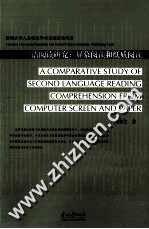图书介绍
二语阅读研究 屏幕阅读和纸质阅读pdf电子书版本下载

- 尤春芝著 著
- 出版社: 贵阳:贵州大学出版社
- ISBN:7811264005
- 出版时间:2011
- 标注页数:218页
- 文件大小:41MB
- 文件页数:238页
- 主题词:第二语言-阅读教学-研究
PDF下载
下载说明
二语阅读研究 屏幕阅读和纸质阅读PDF格式电子书版下载
下载的文件为RAR压缩包。需要使用解压软件进行解压得到PDF格式图书。建议使用BT下载工具Free Download Manager进行下载,简称FDM(免费,没有广告,支持多平台)。本站资源全部打包为BT种子。所以需要使用专业的BT下载软件进行下载。如 BitComet qBittorrent uTorrent等BT下载工具。迅雷目前由于本站不是热门资源。不推荐使用!后期资源热门了。安装了迅雷也可以迅雷进行下载!
(文件页数 要大于 标注页数,上中下等多册电子书除外)
注意:本站所有压缩包均有解压码: 点击下载压缩包解压工具
图书目录
CHAPTER Ⅰ INTRODUCTION 1
1.1 Background of the Study 1
1.2 Statement of the Problem 5
1.3 Purposes of the Study 10
1.4 Research Questions 10
1.5 Definitions of the Key Terms 11
1.6 Significance of the Study 12
1.7 Summary 13
CHAPTER Ⅱ LITERATURE REVIEW 13
2.1 Second Language Reading and Reading Theories 14
2.1.1 The Nature of Second Language Reading 14
2.1.2 Theories in L2 Reading 16
2.2 Text Presentation and Reading Comprehension 22
2.2.1 Theoretical Background 22
2.2.2 Research on Text Presentation and Reading Comprehension 26
2.3 Computer Literacy and Reading Comprehension 31
2.3.1 Theoretical Background 31
2.3.2 Research on Computer Literacy and Comprehension 33
2.4 Text Familiarity and Reading Comprehension 37
2.4.1 Theoretical Background 37
2.4.2 Research on Text Familiarity and Reading Comprehension 37
2.5 Reading Strategies and Reading Comprehension 41
2.5.1 Conceptual Framework of Reading Strategies 41
2.5.2 Classifications of Reading Strategies 42
2.5.3 Assessing Reading Strategies 44
2.5.4 Research on Reading Strategies 44
CHAPTER Ⅲ RESEARCH METHODOLOGY 44
3.1 Rationale for Research Methodology 49
3.2 Subjects 50
3.3 Instruments 50
3.3.1 National Computer Rank Examination(Grade One) 51
3.3.2 Questionnaire 52
3.3.3 Reading Comprehension Test 55
3.3.4 Semi-Structured Interviews 60
3.4 Experimental Design 62
3.5 Research Procedures 62
3.6 Data Analysis 63
3.6.1 Quantitative Data Analysis 63
3.6.1.1 Descriptive Statistics 63
3.6.1.2 ANOVA 65
3.6.1.3 Independent Samples T-test 65
3.6.1.4 Mixed Design ANOVA 65
3.6.2 Qualitative Data Analysis 66
3.7 Pilot Study 66
3.7.1 Subjects 67
3.7.2 Procedures 67
3.7.3 Data Analysis 68
3.7.3.1 Questionnaires 68
3.7.3.2 Reading Comprehension Test 69
3.7.3.3 Semi-Structured Interview 71
3.7.4 Results of the Pilot Study 71
3.7.4.1 Reading Comprehension Test 71
3.7.4.2 Post-Experiment Reading Strategy Questionnaire 74
3.7.5 Implications for the Main Study 77
3.8 Main Study 78
3.8.1 Subjects 78
3.8.2 Data Collection Procedures 80
3.8.2.1 Phase Ⅰ:Pre-Experiment Phase 80
3.8.2.2 Phase Ⅱ:Experimental Phase 81
3.8.2.3 Phase Ⅲ:Post-Experiment Phase 82
3.8.3 Summary 84
CHAPTER Ⅳ RESULTS 85
4.1 Answer to Research Question 1 85
4.1.1 Descriptive Statistics for Text Presentation 85
4.1.2 Mixed Design ANOVA Analysis for Text Presentation 86
4.2 Answer to Research Question 2 87
4.2.1 Descriptive Statistics for Computer Literacy 88
4.2.2 Mixed Design ANOVA Analysis for Computer Literacy 89
4.3 Answer to Research Question 3 90
4.3.1 Descriptive Statistics for Text Familiarity 91
4.3.2 Mixed Design ANOVA Analysis for Text Familiarity 92
4.4 Answer to Research Question 4 93
4.4.1 Two-way Interaction between Text Presentation and Computer Literacy 93
4.4.2 Two-way Interaction between Text Presentation and Text Familiarity 95
4.4.3 Two-way Interaction between Computer Literacy and Text Familiarity 96
4.4.4 Three-way Interaction among Text Presentation,Computer Literacy and Text Familiarity 99
4.5 Answer to Research Question 5 101
4.5.1 Quantitative Data from PERSQ 101
4.5.1.1 Differences in Overall Reading Strategy Use between Two Presentation Groups 103
4.5.1.2 Differences of Subjects'Reading Strategy Use of the Three Subscales between Computer and Paper Group 106
4.5.2 Qualitative Data from Semi-Structured Interview 108
4.6 Answer to Research Question 6 119
4.7 Summary 125
CHAPTER Ⅴ DISCUSSION AND CONCLUSIONS 125
5.1 Discussion 126
5.1.1 Effects of Text Presentation on Reading Comprehension 127
5.1.2 Effects of Computer Literacy on Reading Comprehension 128
5.1.3 Effects of Text Familiarity on Reading Comprehension 130
5.1.4 Interactions between and among Text Presentation,Computer Literacy and Text Familiarity 131
5.1.5 Differences in Overall Reading Strategy Use between Two Presentation Groups 133
5.1.5.1 Reading Strategies Frequently Used and Least Used by Subjects 135
5.1.5.2 Reading Strategies Frequently Used by Subjects 136
5.1.5.3 Reading Strategies Least Used by Subjects 138
5.1.5.4 Differences in the Use of Support Reading Strategies between Reading from Computers and from Paper 140
5.1.6 Attitudes toward Reading from Computers and from Paper 141
5.1.6.1 General Attitudes toward Computer Use 142
5.1.6.2 Preconceptions 142
5.1.6.3 Affective Components of Attitudes towards Reading from Computers and from Paper 143
5.1.6.4 Preference 144
5.2 Conclusions 146
5.3 Implications and Recommendations 149
5.4 Limitations and Suggestions for Further Research 153
5.5 Summary 154
REFERENCES 156
APPENDIX A 171
APPENDIX B 183
APPENDIX C 185
APPENDIX D 200
APPENDIX E 204
APPENDIX F 208
APPENDIX G 210
APPENDIX H 215
LIST OF TABLES 72
Table 3.1 Description of the Four Passages 72
Table 3.2 Frequency of Text Familiarity for Four passages 73
Table 3.3 Results of Item Analysis of Reading Comprehension Test Items 75
Table 4.1 Descriptive Results for Text Presentation 86
Table 4.2 Mixed Design ANOVA Results of the Reading Comprehension for Text Presentation 87
Table 4.3 Descriptive Statistics for Comprehension Means and Standard Deviation in Terms of Computer Literacy 88
Table 4.4 Mixed Design ANOVA Results of the Reading Comprehension in Terms of Computer Literacy 89
Table 4.5 Results of Multiple Comparisons for Computer Literacy 90
Table 4.6 Descriptive Statistics for Reading Comprehension in Terms of Text Familiarity 91